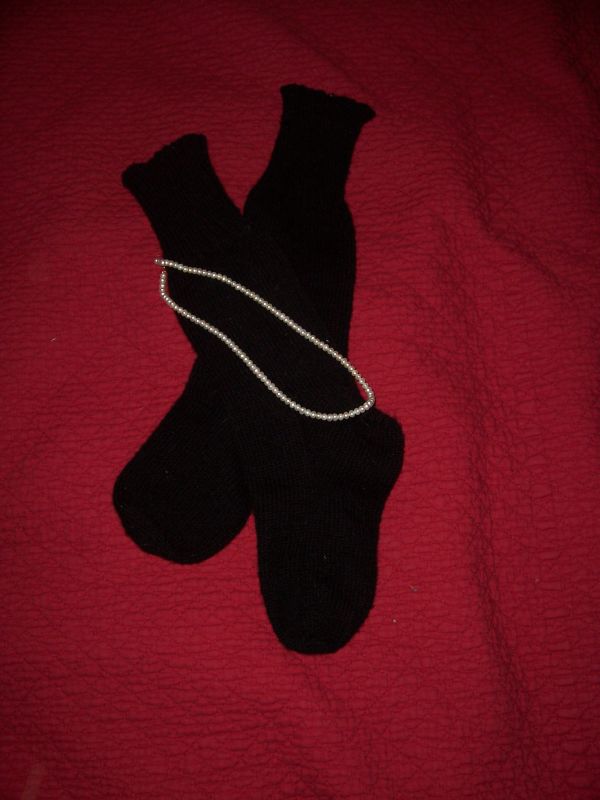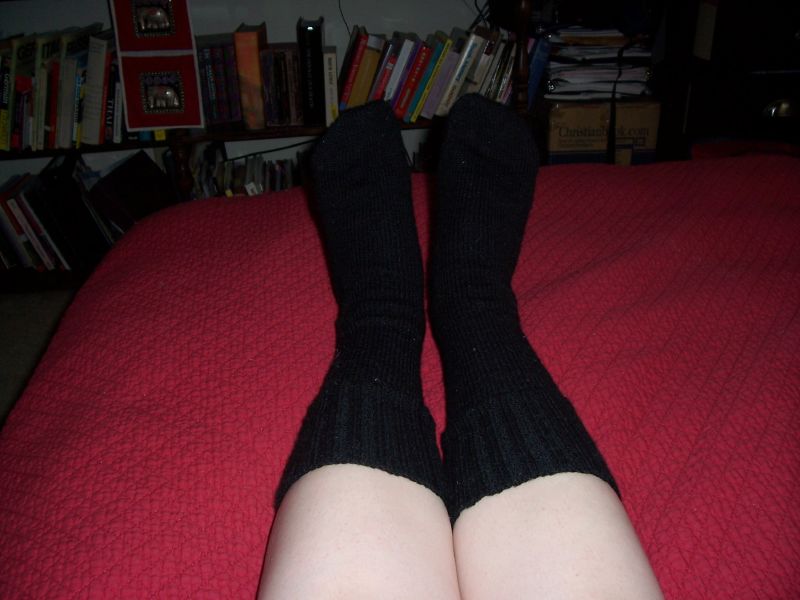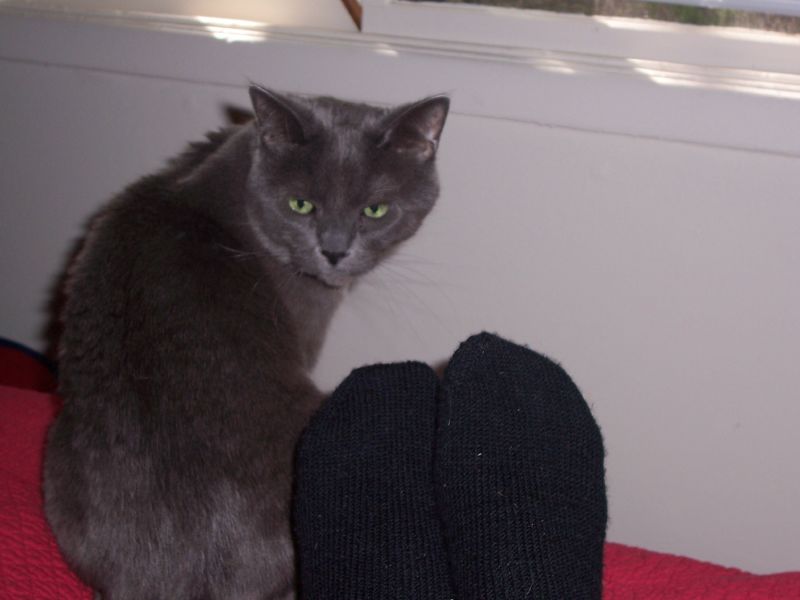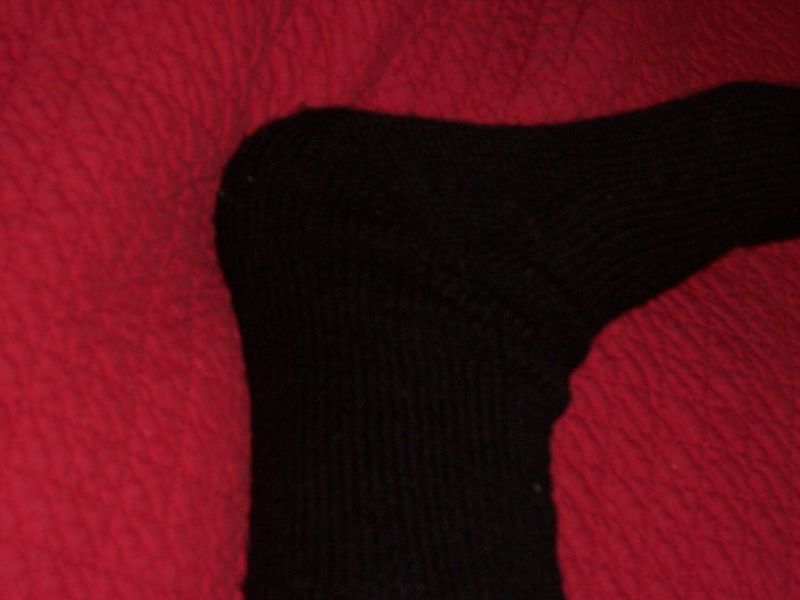Well, with as many fun and crazy sock yarns as there are, and as many that live on my shelf, sometimes, you just need plain black.
I noticed this when I was wearing my awesome little power suit (as seen in the DC trip). I have one pair of fairly somber socks, in tones of grey, that go okay with the grey suit. However, I really wanted a pair of nice, grown-up black dress socks.

And these are about as basic as you can get. I wanted the use the yarn efficiently, so I decided to do them toe-up. I'm glad I did, because while I got very high socks that won't show my ankle if the pant leg rides up a bit, I didn't quite get knee socks either.

I started with the rectangle toe, which is pretty much the only way I care to do a toe-up toe at this point. I have done the Turkish/figure 8 cast on, I understand the principle. It's just entirely too fiddly. Instead, you knit a little rectangle and pick up all around. You then increase at each side just where you would decrease in a normal toe. Worfy is not terribly impressed, however.

The heel is a nice, no wrap sort of heel that feels like a larger version of the way you turn a heel with a cuff-down toe flap sock. It's basically the Fleegle heel, though I deviate from her pattern elsewhere. It also has the advantage that it's easily memorized, a problem I was having with toe up socks in general. You see, I like socks to by my basic, hanging around in my purse project, that I can knit in the dark. I have the cuff-down, heel-flap version memorized, and even the afterthought, but I had nothing for toe up. Add in the part where almost every other short-row heel (which most toe up patterns seem to use) has given me wide gaps, and I have a winner.

When I got to the top, I started doing something that looked a little silly. I wound the yarn in the opposite direction, and worked on the second sock right away, up to and a little beyond the same point. I kept going back and forth like this until I had used up most of the yarn and they were even. Yes, I could have wound the yarn into two equal skeins before I started, but that would require forethought. It's a really great idea to do, though, because you wind up with two socks done at about the same time, eliminating the dreaded Second Sock Syndrome. While the more efficient method would also have involved two sets of needles, a piece of scrap yarn works just as well while you transfer the ones you're using to the other sock.
The cuff is plain in stockinette up until about the normal sock length (the height of my hand, bottom of palm to tip of middle finger), and then switches into 2x2 ribbing. The reason I changed there is because that's where socks start to require some calf shaping. Now, I could have kept track of how many rows I had done in stockinette, or I could have read my increases, but both of those would have required effort. So I switched to ribbing, increasing while I did so, and let the ribbing accomodate more of the stretch as well. The big bonus about increasing while switching from stockinette to ribbing, aside from being easy to tell where you began, is that it's fairly easy to hide the increases. When you knit into the front and back of the same stitch, the first stitch looks like a regular knit and the second stitch leaves a little bar that is almost indistinguishable from a regular purl bump. You can see where I'm going here. So to increase nicely into 2x2 ribbing, do (K1, K f/b, P1), wherever you need to. I'd show you here, but the fabric is black, and you'd all think I was doing that to hide my mistakes. I promise, I'll show you on some bright fabric sometime.
The cuff continues in 2x2 rib until I was pretty much out of yarn. I finished with Elizabeth Zimmerman's sewn bind off, which is extremely stretchy. Stretchy is crucial if you ever want to get the sock over your calf. I can show you that sometime too, if you like.

So anyway, basic socks, but the construction was pretty fun. And it's black, so if I knit in the movie theater, it doesn't matter, because I can't see the fabric anyway.
In Summary:
Pattern: See above
Yarn: Cherry Tree Hill Supersock (100% superwash wool), black, 1 skein
Needles: Size US 1 (2.25 mm) dpn (set of 5)
Time: About two weeks, I think
Cost: Around $20

3 comments:
Hmmmm! ! ! Lorna's "little child" and little Worfy have a lot in common----no offense---why black?
But I think black would be "fantastic" and especially with different instructions. Is there another trip in the making?
Enjoy Carol
Those are very handsome black socks..I am sure that you will get quite a bit of use out of them. In just the esoterica of the day, the last three letters of the word verification were toe...how appropriate.
Nice socks. Oh and BTW- you have been tagged with a meme.
Post a Comment